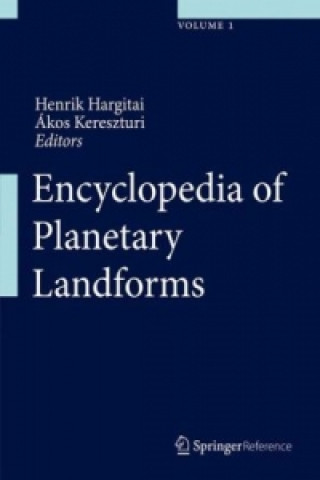
Доставка
Наръчник за пазаруване





Не ви допада? Няма проблеми! При нас имате възможност за връщане в рамките на 30 дни
 Подаръчен ваучер
на всякаква стойност
Подаръчен ваучер
на всякаква стойност
Няма да сбъркате с подаръчен ваучер. Получателят може да избере нещо от нашия асортимент с подаръчен ваучер.
Encyclopedia of Planetary Landforms
 Английски език
Английски език
 1632 b
1632 b
30 дни за връщане на стоката
Може би ще Ви заинтересува


The technique of the mapping of planetary surfaces and the methods used for the identification of various planetary landforms improved much in the last 400 years. Until the 20th century, telescopic observers could interpret planetary landforms solely based on their appearance, while today various data sets acquired by space probes can be used for a more detailed analysis on the composition and origin of the surface features.§§Before the Greeks, the Earth and the Heavens were indisputably of different origin and nature. It was a major philosophical breakthrough - first appeared as an a priori theory, later based on observations - that the Heavens (planetary bodies) and the Earth share common features: gravity, composition and solar distance may be different, but the nature of the physical processes shaping the landforms are essentially the same. It has been a long way since we have arrived from the first telescopic description of lunar craters to the identification of various geological formations on Mars or on minor planets.§§Relief features of the Moon have first been observed by Galileo Galilee, via his telescope. During the next centuries, a multitude of Lunar landforms have been identified. Theories based on observations have been connected together by a scientific paradigm which explained their origin in a logical and seemingly undisputable manner. Telescopes showed a Lunar surface full of circular landforms, called craters, a landscape with no parallel on Earth. But the individual landforms had a morphological equivalent, volcanoes, which naturally led to the conclusion that craters had been created by volcanic processes. Maria ("seas") served as natural basins for water bodies. Observations clearly showed that water and air are hardly found on the Moon, the lack of clouds indicated the lack of precipitation. But the flat surface of the maria (obviously composed of marine sediments) and the meandering valleys suggested the presence of liquid water and a higher atmospheric pressure in the past - during the age of active volcanism and degassing. There were no observable active volcanic processes but some craters (though to be volcanoes) have been observed as being active: flashes of light - interpreted as eruptions - have been reported by several observers. The presence of pyroclasts thrown out from the volcanic vents of craters provided an independent evidence: meteor showers and individual meteorites falling from the sky - originating from Lunar craters. The logical and interconnected set of explanations based on observations proved to be completely false by the second half of the 20th century. The new paradigm interpreted the very same features in a new context.§§The case of Mars was different. There were no telescopes capable of observing relief forms (no shadows on Mars are visible from the Earth, because Mars always shows a nearly full Mars phase), so only albedo features could be seen and used for interpretation. The lack of visible relief features were interpreted as a lack of considerable topography: an unnoticed distortion in the observational data. The hue and contrast of dark and bright, orange, grey and white spots have changed seasonally, the polar areas clearly showed a polar cap made of ice and snow, but clouds have not been observed. Since Mars is farther away from the Sun than the Earth, it was evident that temperature values are lower there. Scientists concluded that Mars is an ancient, arid world. Then contemporary geology taught the theory according to which waters on the Earth are going to infiltrate underground in time, making the surface dry - observations showed that this had already happened on Mars. The last surface reservoirs of water were the polar caps. Some observers reported seeing a global network of linear features, but other have only seen very few of such albedo markings. These features were interpreted as "canals," made by a civilization for irrigation,
Информация за книгата
 Английски език
Английски език
Категории


 Контакт
Контакт Как се пазарува?
Как се пазарува?
























